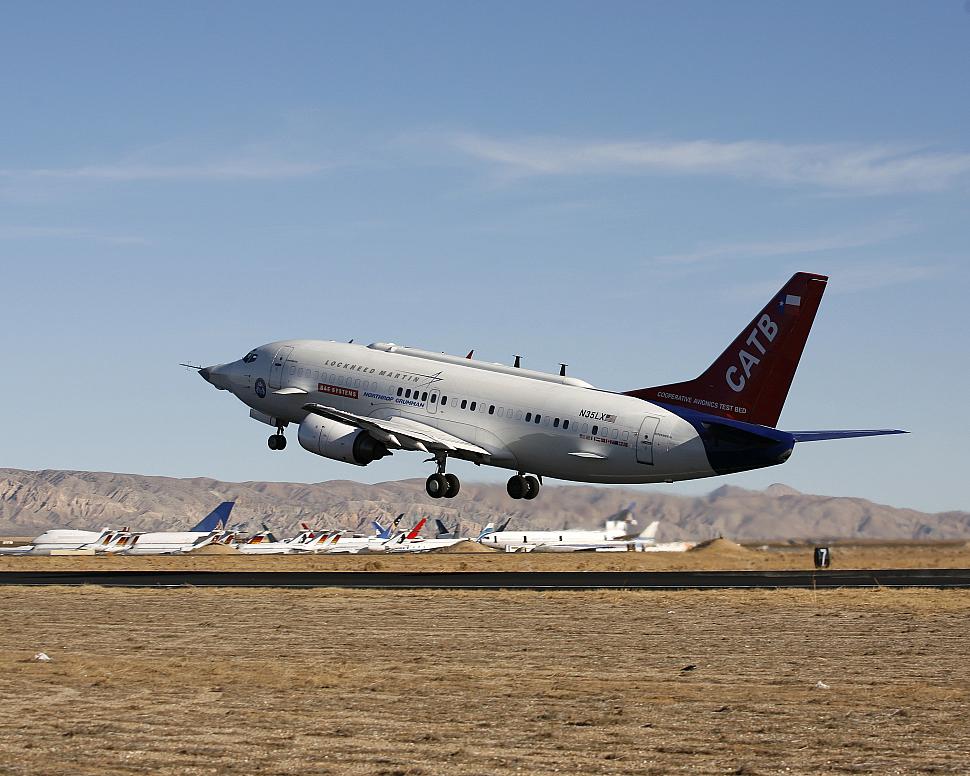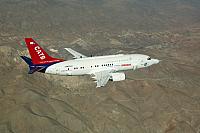Fighter Jet News
F-35 Lightning II News
F-35 Lightning II avionics test bed takes wing BAE systems
January 25, 2007 (by
Lieven Dewitte) -
The Joint Strike Fighter Cooperative Avionics Test Bed (CATB), a 737-300 aircraft extensively modified by BAE Systems, successfully completed its maiden flight Jan. 23 at Mojave, California.

The flight capped a nearly three-year effort to transform a commercial airliner into a flying laboratory for Lockheed Martin's F-35 Lightning II stealth fighter.
The 737 aircraft, also known as the "CAT-Bird," is a flying test bed that replicates the F-35 avionics suite. The CATB will develop and verify the F-35's capability to collect data from multiple sensors and fuse it into a coherent situational awareness display in a dynamic airborne environment.
"Today's flight caps what has been a significant technical challenge," said John Wall, BAE Systems CATB program director in Mojave, where the work was performed. "The CAT-Bird is helping the Lightning II take its place as the premier fighter aircraft serving the U.S. and multi-nation partners for decades to come."
The CAT-Bird now begins a one-month test flight phase to prove the aerodynamics of the converted airliner — an important validation because of modifications to the craft made to accommodate the avionics test requirements. These include the addition of a nose extension to simulate that of the F-35, a 42-foot-long spine on the top, a 10-foot "canoe" on the bottom to accommodate electronic equipment, and twin 12-foot sensor wings that replicate the leading edge of the F-35's wings.
The inside of the plane also was transformed. An F-35 cockpit will allow the sensor inputs to be displayed as they would be in the fighter itself. The rest of the interior houses equipment racks for the avionics equipment, and 20 workstations for technicians to assess the performance of the avionics.
"The CAT-Bird is a vitally important and powerful tool in Lockheed Martin's arsenal for early risk mitigation and maturation of the F-35," said Doug Pearson, Lockheed Martin's vice president of the F-35 Integrated Test Force. "It allows us to concurrently develop and integrate mission systems hardware and software well before it is installed on F-35s. We congratulate BAE Systems on today's successful first flight and look forward to many years of productive flight test operation."
Today's flight was the first of about 20 sorties that will comprise CAT-Bird's initial test phase. After conclusion of some additional modification work, and the initial flight test phase, the B-737 CATB will transition to its home base and begin test operations at Lockheed Martin Aeronautics in Fort Worth, Texas. The CAT-Bird will be used to develop and evaluate the F-35's extensive sensor architecture.

A 737-300 aircraft extensively modified by BAE Systems takes of for its maiden flight Jan. 23 at Mojave, California. This aircraft known as the "CAT-Bird", is a flying test bed that replicates the F-35 avionics suite. [LMTAS photo]
The 737 aircraft, also known as the "CAT-Bird," is a flying test bed that replicates the F-35 avionics suite. The CATB will develop and verify the F-35's capability to collect data from multiple sensors and fuse it into a coherent situational awareness display in a dynamic airborne environment.
"Today's flight caps what has been a significant technical challenge," said John Wall, BAE Systems CATB program director in Mojave, where the work was performed. "The CAT-Bird is helping the Lightning II take its place as the premier fighter aircraft serving the U.S. and multi-nation partners for decades to come."
The CAT-Bird now begins a one-month test flight phase to prove the aerodynamics of the converted airliner — an important validation because of modifications to the craft made to accommodate the avionics test requirements. These include the addition of a nose extension to simulate that of the F-35, a 42-foot-long spine on the top, a 10-foot "canoe" on the bottom to accommodate electronic equipment, and twin 12-foot sensor wings that replicate the leading edge of the F-35's wings.
The inside of the plane also was transformed. An F-35 cockpit will allow the sensor inputs to be displayed as they would be in the fighter itself. The rest of the interior houses equipment racks for the avionics equipment, and 20 workstations for technicians to assess the performance of the avionics.
"The CAT-Bird is a vitally important and powerful tool in Lockheed Martin's arsenal for early risk mitigation and maturation of the F-35," said Doug Pearson, Lockheed Martin's vice president of the F-35 Integrated Test Force. "It allows us to concurrently develop and integrate mission systems hardware and software well before it is installed on F-35s. We congratulate BAE Systems on today's successful first flight and look forward to many years of productive flight test operation."
Today's flight was the first of about 20 sorties that will comprise CAT-Bird's initial test phase. After conclusion of some additional modification work, and the initial flight test phase, the B-737 CATB will transition to its home base and begin test operations at Lockheed Martin Aeronautics in Fort Worth, Texas. The CAT-Bird will be used to develop and evaluate the F-35's extensive sensor architecture.
Additional images:

The modified 737-300 known as the "CAT-Bird" is seen here over the Mojave desert on its maiden flight Jan. 23 2007. The aircraft develops and verifies the F-35's capability to collect data from multiple sensors and fuse it into a coherent situational awareness display in a dynamic airborne environment. [LMTAS photo]
